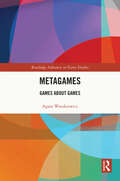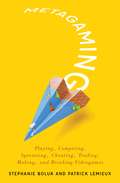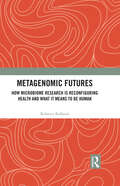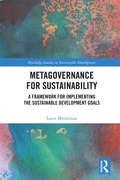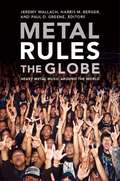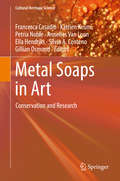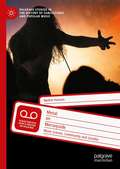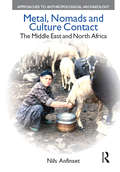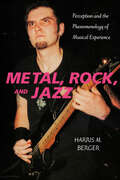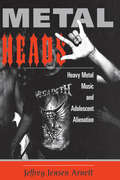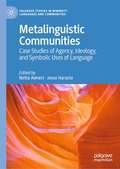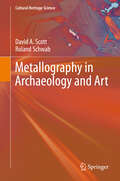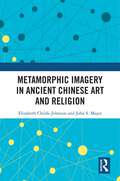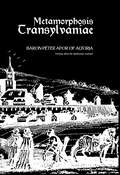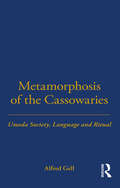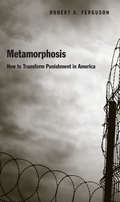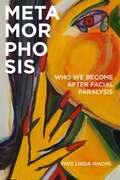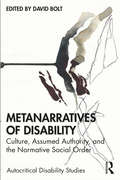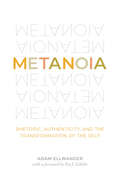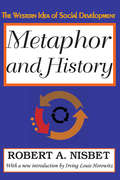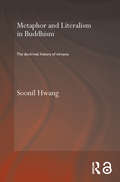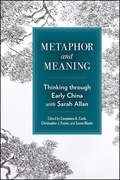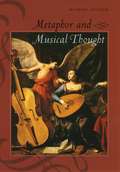- Table View
- List View
Metagames: Games about Games (ISSN)
by Agata WaszkiewiczMetagames: Games about Games scrutinizes how various meta devices, such as breaking the fourth wall and unreliable narrator, change and adapt when translated into the uniquely interactive medium of digital games.Through its theoretical analyses and case studies, the book shows how metafictional experimentation can be used to both challenge and push the boundaries of what a game is and what a player’s role is in play, and to raise more profound topics such as those describing experiences of people of oppressed identities. The book is divided into six chapters that deal with the following meta devices: breaking the fourth wall, hypermediation, unreliable narrator, abusive game design, fragmentation, and parody.The book will predominantly interest scholars and students of media studies and game studies as it continues discourses held in the discipline regarding the metareferential character of digital games.
Metagaming: Playing, Competing, Spectating, Cheating, Trading, Making, and Breaking Videogames (Electronic Mediations #53)
by Stephanie Boluk Patrick LeMieuxThe greatest trick the videogame industry ever pulled was convincing the world that videogames were games rather than a medium for making metagames. Elegantly defined as &“games about games,&” metagames implicate a diverse range of practices that stray outside the boundaries and bend the rules: from technical glitches and forbidden strategies to Renaissance painting, algorithmic trading, professional sports, and the War on Terror. In Metagaming, Stephanie Boluk and Patrick LeMieux demonstrate how games always extend beyond the screen, and how modders, mappers, streamers, spectators, analysts, and artists are changing the way we play.Metagaming uncovers these alternative histories of play by exploring the strange experiences and unexpected effects that emerge in, on, around, and through videogames. Players puzzle through the problems of perspectival rendering in Portal, perform clandestine acts of electronic espionage in EVE Online, compete and commentate in Korean StarCraft, and speedrun The Legend of Zelda in record times (with or without the use of vision). Companies like Valve attempt to capture the metagame through international e-sports and online marketplaces while the corporate history of Super Mario Bros. is undermined by the endless levels of Infinite Mario, the frustrating pranks of Asshole Mario, and even Super Mario Clouds, a ROM hack exhibited at the Whitney Museum of American Art.One of the only books to include original software alongside each chapter, Metagaming transforms videogames from packaged products into instruments, equipment, tools, and toys for intervening in the sensory and political economies of everyday life. And although videogames conflate the creativity, criticality, and craft of play with the act of consumption, we don&’t simply play videogames—we make metagames.
Metagenomic Futures: How Microbiome Research is Reconfiguring Health and What it Means to be Human
by Roberta RaffaetàThis book is an ethnographic exploration of what it means to be human from a more-than-human perspective, the microbial perspective. It engages with the scientific study of the microbiome and the vast microbial biodiversity that surrounds and constitutes us. Microbes connect human bodies with the environment in which they live and have important implications for both human and environmental health. Scientists studying the microbiome are explorers of uncharted life and in this venture they are constrained by onto-epistemic working practices grounded in the reductionist paradigm of molecular biology. At the same time, however, they configure the microbiome ecosystem as an aspirational form of ecological co-habitation. The aim of the book is to critically explore the ethical, political and ontological implications of microbiome science in times of profound socio-technical and ecological transition and engage with them productively from an anthropological perspective. It suggests ways to revitalize current debates within medical anthropology, environmental anthropology, science and technology studies and anthropology at large, especially with regard to posthumanism, the ontological turn and critical data study.
Metagovernance for Sustainability: A Framework for Implementing the Sustainable Development Goals (Routledge Studies in Sustainable Development)
by Louis MeulemanThe 17 Sustainable Development Goals (SDGs) which were adopted by the United Nations in September 2015 are universally applicable in all 193 UN Member States and connect the big challenges of our time, such as hunger and poverty, climate change, health in an urbanised environment, sustainable energy, mobility, economic development and environmental degradation. Sustainability has the characteristics of a ‘wicked problem’, for which there are no one-size-fits-all solutions. This book tests the hypothesis that the implementation of sustainable development, and in particular the 2015 SDGs, requires tailor-made metagovernance or ‘governance of governance’. This is necessary to develop effective governance and high quality and inclusive public administration and to foster policy and institutional coherence to support implementing the SDGs. Based on the growing literature on governance and metagovernance, and taking into account the specificities of societal factors such as different values and traditions in different countries, the book presents a framework for the design and management of SDG implementation. It shows how hierarchical, network and market governance styles can be combined and how governance failure can be prevented or dealt with. The book presents an overview of fifty ‘shades of governance’ which differ for each governance style, and a sketch of a concrete method to apply sustainability metagovernance. Metagovernance for Sustainability is relevant to academic and practitioner fields across many disciplines and problem areas. It will be of particular interest to scholars, students and policy-makers studying Sustainable Development, Governance and Metagovernance, Public Management and Capacity Building.
Metal Rules the Globe: Heavy Metal Music around the World
by Harris M. Berger Paul D. Greene Jeremy WallachDuring the past three decades, heavy metal music has gone global, becoming a potent source of meaning and identity for fans around the world. In Metal Rules the Globe, ethnographers and some of the foremost authorities in the burgeoning field of metal studies analyze this dramatic expansion of heavy metal music and culture. They take readers inside metal scenes in Brazil, Canada, China, Easter Island, Indonesia, Israel, Japan, Malaysia, Malta, Nepal, Norway, Singapore, Slovenia, and the United States, describing how the sounds of heavy metal and the meanings that metalheads attribute to them vary across cultures. The contributors explore the dynamics of masculinity, class, race, and ethnicity in metal scenes; the place of metal in the music industry; and the ways that disenfranchised youth use metal to negotiate modernity and social change. They reveal heavy metal fans as just as likely to criticize the consumerism, class divisiveness, and uneven development of globalization as they are to reject traditional cultural norms. Crucially, they never lose sight of the sense of community and sonic pleasure to be experienced in the distorted, pounding sounds of local metal scenes.Contributors. Idelber Avelar, Albert Bell, Dan Bendrups, Harris M. Berger, Paul D. Greene, Ross Hagen, Sharon Hochhauser, Shuhei Hosokawa, Keith Kahn-Harris, Kei Kawano, Rajko Muršič,Steve Waksman, Jeremy Wallach, Robert Walser, Deena Weinstein, Cynthia P. Wong
Metal Soaps in Art: Conservation and Research (Cultural Heritage Science)
by Francesca Casadio Katrien Keune Petria Noble Annelies Van Loon Ella Hendriks Silvia A. Centeno Gillian OsmondThis go-to reference work surveys the current state of knowledge in the field of metal soap-related degradation phenomena in art works. It contains detailed descriptions and images of the different phenomena and addresses the practical aspects of soap formation, preventive conservation, and treatment.The occurrence of metal soaps is one of the defining issues in the conservation of painted surfaces, and one that presently leaves innumerable open questions. It is estimated that around 70% of paintings in museum collections are affected by some form of metal soap-related degradation. In recent years, significant advances have been made in the detection and characterization of these compounds through interdisciplinary approaches including conventional spectroscopy and microscopy as well as emerging synchrotron-based techniques. This book for the first time captures a panoramic overview of the state of knowledge of metal soaps related to both scientific analysis and implications for conservation and treatment. It also critically examines open questions. The book is accessible to audiences with varied backgrounds (e.g. conservators, students of conservation science) while simultaneously presenting the technical details indispensable for academics and researchers active in this field.
Metal on Merseyside: Music Scenes, Community and Locality (Palgrave Studies in the History of Subcultures and Popular Music)
by Nedim HassanThis is the first book to examine the partially hidden history of metal music scenes within the city of Liverpool and the surrounding region of Merseyside in the North-West of England. It reveals that while Liverpool has historically been portrayed as a certain kind of ‘music city,’ metal has been marginalized within its music heritage narratives. This marginality was not inevitable. The book illustrates how it is not merely the product of historical representation but the result of forces of urban change and regional shifts in the economy of live music. Nor is this marginality inconsequential. Drawing on ethnographic research, Nedim Hassan demonstrates that it has influenced how the region’s metal scenes are perceived and how people feel towards them. Metal on Merseyside reveals how various people involved with such scenes work within often challenging circumstances to sustain the production of metal music and events. It also reveals the tensions that arise as scene members’ desires for an ideal metal community collide with forces of change. Metal on Merseyside is, therefore, a fascinating barometer for the contradictions apparent when people engage in creative labour to produce music that they love.
Metal, Nomads and Culture Contact: The Middle East and North Africa (Approaches To Anthropological Archaeology Ser.)
by Nils AnfinsetThe fifth and fourth millennia BCE saw major cultural changes in the southern Levant and Northeast Africa: the spread of agriculture; developments in animal husbandry; increased contact between cultures; and the use of alloy bronze. 'Metal, Nomads and Culture Contact' integrates archaeological data from across the Chalcolithic period to contextualise these changes. The book examines the introduction of metal to the southern Levant, Egypt and Lower Nubia and the role of pastoral nomadism in cultural interaction and exchange. 'Metal, Nomads and Culture Contact' will be valuable to scholars of archaeology and anthropology.
Metal, Rock, and Jazz: Perception and the Phenomenology of Musical Experience (Music Culture)
by Harris M. BergerA lively comparison of musical meaning in Ohio's Jazz, metal, and hard rock scene. This vivid ethnography of the musical lives of heavy metal, rock, and jazz musicians in Cleveland and Akron, Ohio shows how musicians engage with the world of sound to forge meaningful experiences of music. Unlike most popular music studies, which only provide a scholar's view, this book is based on intensive fieldwork and hundreds of hours of in-depth interviews. Rich descriptions of the musical life of metal bars and jazz clubs get readers close to the people who make and listen to the music. Of special interest are Harris M. Berger's interviews with Timmy "The Ripper" Owens, now famous as lead singer for the pioneering heavy metal band, Judas Priest. Owens and other performers share their own experiences of the music, thereby challenging traditional notions of harmony and musical structure. Using ideas from practice theory and phenomenology, Berger shows that musical perception is a kind of practice, both creatively achieved by the listener and profoundly informed by social context.
Metalheads: Heavy Metal Music and Adolescent Alienation
by Jeffrey Arnett<p>Heavy metal is a violent, head-bashing music complete, in its live performances, with its own arena of rage and celebration, the mosh pit. It is a music in the red corner of society, loud, angry, and, to a well-tuned ear, practically intolerable. And yet, the art form radiates a message about American adolescents well worth examining and comprehending: Its devotees, primarily adolescent boys, are alienated from their world and angry about its future. <p>Heavy metal speaks throbbingly the message of rage, loneliness, and cynicism.In this sensitive book, Jeffrey Jensen Arnett synthesizes the stories and experiences of seventy male and thirty-eight female “metalheads” in a successful attempt to understand the often crippling results of a society and an image of the nuclear family steeped in conformity, self-denial, and obedience. The vacuum such an atmosphere creates in the individual can be temporarily obliterated by a heavy metal concert, which Arnett sees as a substitute manhood ritual. This conclusion is just one of the many striking hypotheses the author advances in this dynamic study of a music and its followers. <p>Of the one hundred metalheads interviewed for this volume, ten have allowed themselves to be profiled in depth—the reader becomes fully acquainted with Jack, for instance, and with the multiple crosses decorating his body, his black rose tattoo, and his tumultuous family life; or with slim and well-groomed Jean dressed entirely in black, her favorite color, and wearing the temperament of withdrawal. This is a unique study filled with compassion for a disenfranchised subculture and the respect to want to understand it.</p>
Metalinguistic Communities: Case Studies of Agency, Ideology, and Symbolic Uses of Language (Palgrave Studies in Minority Languages and Communities)
by Netta Avineri Jesse HarastaThis edited volume brings together ten compelling ethnographic case studies from a range of global settings to explore how people build metalinguistic communities defined not by use of a language, but primarily by language ideologies and symbolic practices about the language. The authors examine themes of agency, belonging, negotiating hegemony, and combating cultural erasure and genocide in cultivating meaningful metalinguistic communities. Case studies include Spanish and Hebrew in the USA, Kurdish in Japan, Pataxó Hãhãhãe in Brazil, and Gallo in France. The afterword, by Wesley L. Leonard, provides theoretical and on-the-ground context as well as a forward-looking focus on metalinguistic futurities. This book will be of interest to interdisciplinary students and scholars in applied linguistics, linguistic anthropology and migration studies.
Metallography in Archaeology and Art (Cultural Heritage Science)
by David A. Scott Roland SchwabThis book provides a comprehensive introduction to the metallographic study of ancient metals. Metallography is important both conceptually as a microstructural science and in terms of its application to the study of ancient and historic metals. Metallography is a well-established methodology for the characterization of the microstructure of metals, which continues to be significant today in quality control and characterization of metallic properties. Not only does the metallographic examination of ancient metals present its own challenges in terms of sample size and interpretation of evidence, but it must be integrated with archaeological data and cultural research in order to obtain the most meaningful results. Issues of authentication and the establishment of fakes and forgeries of metallic artefacts often involve metallographic evidence of both metal and patina or corrosion interface, as an essential component of such a study. The present volume sets out the basic features of relevant metallic systems, enhanced with a series of examples of typical microstructural types, with illustrative case studies and examples throughout the text derived from studies undertaken by the two authors. This book provides a comprehensive presentation of metallography for archaeologists, archaeometallurgists, conservators, conservation scientists and metallurgists of modern materials.
Metamorphic Imagery in Ancient Chinese Art and Religion
by John S Major Elizabeth Childs-JohnsonMetamorphic Imagery in Ancient Chinese Art and Religion demonstrates that the concept of metamorphism was central to ancient Chinese religious belief and practices from at least the late Neolithic period through the Warring States Period of the Zhou dynasty. Central to the authors' argument is the ubiquitous motif in early Chinese figurative art, the metamorphic power mask. While the motif underwent stylistic variation over time, its formal properties remained stable, underscoring the image’s ongoing religious centrality. It symbolized the metamorphosis, through the phenomenon of death, of royal personages from living humans to deceased ancestors who required worship and sacrificial offerings. Treated with deference and respect, the royal ancestors lent support to their living descendants, ratifying and upholding their rule; neglected, they became dangerous, even malevolent. Employing a multidisciplinary approach that integrates archaeologically recovered objects with literary evidence from oracle bone and bronze inscriptions to canonical texts, all situated in the appropriate historical context, the study presents detailed analyses of form and style, and of change over time, observing the importance of relationality and the dynamic between imagery, materials, and affects. This book is a significant publication in the field of early China studies, presenting an integrated conception of ancient art and religion that surpasses any other work now available.
Metamorphic Imagery in Ancient Chinese Art and Religion
by John S Major Elizabeth Childs-JohnsonMetamorphic Imagery in Ancient Chinese Art and Religion demonstrates that the concept of metamorphism was central to ancient Chinese religious belief and practices from at least the late Neolithic period through the Warring States Period of the Zhou dynasty. Central to the authors' argument is the ubiquitous motif in early Chinese figurative art, the metamorphic power mask. While the motif underwent stylistic variation over time, its formal properties remained stable, underscoring the image’s ongoing religious centrality. It symbolized the metamorphosis, through the phenomenon of death, of royal personages from living humans to deceased ancestors who required worship and sacrificial offerings. Treated with deference and respect, the royal ancestors lent support to their living descendants, ratifying and upholding their rule; neglected, they became dangerous, even malevolent. Employing a multidisciplinary approach that integrates archaeologically recovered objects with literary evidence from oracle bone and bronze inscriptions to canonical texts, all situated in the appropriate historical context, the study presents detailed analyses of form and style, and of change over time, observing the importance of relationality and the dynamic between imagery, materials, and affects. This book is a significant publication in the field of early China studies, presenting an integrated conception of ancient art and religion that surpasses any other work now available.
Metamorphosis Transylvaniae
by AporFirst published in 2005. Routledge is an imprint of Taylor & Francis, an informa company.
Metamorphosis of the Cassowaries: Umeda Society, Language and Ritual Volume 51 (London School Of Economics Monographs On Social Anthropology Ser. #No. 51)
by Alfred GellIn this substantial book, Gell guides the reader systematically through an analysis of the social structure, language and ritual of the Umedia-Punda connubium of the West Sepik district. One of the central areas explored is the ida fertitility ritual and the decipherment and the unravelling of symbolic relationships between words of similar construction. One one side is the anaylsis on the temporal sequence of events (or ritual roles) metamorphosing the casswary (nature) into the 'new man' (culture) and the on other side, the associated 'harmonic levels' which allude to body painting, choreography and social status. His approach substantiates the view that the ritual is not so much about the establishing of linear causality in the relationship between a society and its environment, but with the 'an act of poetic legislation over the course of nature'.
Metamorphosis: How to Transform Punishment in America
by Robert A FergusonIn the past few years, the need for prison reform in America has reached the level of a consensus. We agree that many prison terms are too long, especially for nonviolent drug offenders; that long-term isolation is a bad idea; and that basic psychiatric and medical care in prisons is woefully inadequate. Some people believe that contracting out prison services to for-profit companies is a recipe for mistreatment. Robert Ferguson argues that these reforms barely scratch the surface of what is wrong with American prisons: an atmosphere of malice and humiliation that subjects prisoners and guards alike to constant degradation. Bolstered by insights from hundreds of letters written by prisoners, Ferguson makes the case for an entirely new concept of prisons and their purpose: an “inner architectonics of reform” that will provide better education for all involved in prisons, more imaginative and careful use of technology, more sophisticated surveillance systems, and better accountability.
Metamorphosis: Who We Become after Facial Paralysis
by Faye Linda WachsLosing her smile to synkinesis after unresolved Bell’s palsy changed how Faye Linda Wachs was seen by others and her internal experience of self. In Metamorphosis, interviewing over one hundred people with acquired facial difference challenged her presumptions about identity, disability, and lived experience. Participants described microaggressions, internalizations, and minimalizations and their impact on identity. Heartbreakingly, synkinesis disrupts the ability to have shared moments. When one experiences spontaneous emotion, wrong nerves trigger misfeel and misperception by others. One is misread by others and receives confusing internal information. Communication of and to the self is irrevocably damaged. Wachs describes the experience as a social disability. People found a host of creative ways to reinvigorate their sense of self and self-expression. Like so many she interviewed, Wachs experiences a process of change and growth as she is challenged to think more deeply about ableism, identity, and who she wants to be.
Metanarratives of Disability: Culture, Assumed Authority, and the Normative Social Order (Autocritical Disability Studies)
by David BoltThis book explores multiple metanarratives of disability to introduce and investigate the critical concept of assumed authority and the normative social order from which it derives. The book comprises 15 chapters developed across three parts and, informed by disability studies, is authored by those with research interests in the condition on which they focus as well as direct or intimate experiential knowledge. When out and about, many disabled people know only too well what it is to be erroneously told the error of our/their ways by non-disabled passers-by, assumed authority often cloaked in helpfulness. Showing that assumed authority is underpinned by a displacement of personal narratives in favour of overarching metanarratives of disability that find currency in a diverse multiplicity of cultural representations – ranging from literature to film, television, advertising, social media, comics, art, and music – this work discusses how this relates to a range of disabilities and chronic conditions, including blindness, autism, Down syndrome, diabetes, cancer, and HIV and AIDS. Metanarratives of Disability will be of interest to all scholars and students of disability studies, medical sociology, medical humanities, education studies, cultural studies, and health.
Metanoia: Rhetoric, Authenticity, and the Transformation of the Self
by Adam EllwangerWestern culture is in a moment when wholly new kinds of personal transformations are possible, but authentic transformation requires both personal testimony and public recognition. In this book, Adam Ellwanger takes a distinctly rhetorical approach to analyzing how the personal and the public relate to an individual’s transformation and develops a new vocabulary that enables a critical assessment of the concept of authenticity. The concept of metanoia is central to this project. Charting the history of metanoia from its original use in the classical tradition to its adoption by early Christians as a term for religious conversion, Ellwanger shows that metanoia involves a change within a person that results in a truer version of him- or herself—a change in character or ethos. He then applies this theory to our contemporary moment, finding that metanoia provides unique insight into modern forms of self-transformation. Drawing on ancient and medieval sources, including Thucydides, Plato, Paul the Apostle, and Augustine, as well as contemporary discourses of self-transformation, such as the public testimonies of Caitlyn Jenner and Rachel Dolezal, Ellwanger elucidates the role of language in signifying and authenticating identity. Timely and original, Ellwanger’s study formulates a transhistorical theory of personal transformation that will be of interest to scholars working in social theory, philosophy, rhetoric, and the history of Christianity.
Metanoia: Rhetoric, Authenticity, and the Transformation of the Self (G - Reference, Information And Interdisciplinary Subjects Ser.)
by Adam EllwangerWestern culture is in a moment when wholly new kinds of personal transformations are possible, but authentic transformation requires both personal testimony and public recognition. In this book, Adam Ellwanger takes a distinctly rhetorical approach to analyzing how the personal and the public relate to an individual’s transformation and develops a new vocabulary that enables a critical assessment of the concept of authenticity. The concept of metanoia is central to this project. Charting the history of metanoia from its original use in the classical tradition to its adoption by early Christians as a term for religious conversion, Ellwanger shows that metanoia involves a change within a person that results in a truer version of him- or herself—a change in character or ethos. He then applies this theory to our contemporary moment, finding that metanoia provides unique insight into modern forms of self-transformation. Drawing on ancient and medieval sources, including Thucydides, Plato, Paul the Apostle, and Augustine, as well as contemporary discourses of self-transformation, such as the public testimonies of Caitlyn Jenner and Rachel Dolezal, Ellwanger elucidates the role of language in signifying and authenticating identity. Timely and original, Ellwanger’s study formulates a transhistorical theory of personal transformation that will be of interest to scholars working in social theory, philosophy, rhetoric, and the history of Christianity.
Metaphor and History: The Western Idea of Social Development
by Robert NisbetThe primary purpose of Metaphor and History is to explain the sources and contexts of the Western idea of social development. Nisbet explores the concept of social change across the whole range of Western culture, from ancient Greece to the present day. He does not see the idea of social development as a nineteenth-century phenomenon or a by-product of the idea of biological evolution.
Metaphor and Literalism in Buddhism: The Doctrinal History of Nirvana
by Soonil HwangSoonil Hwang studies the doctrinal development of nirvana in the Pali Nikaaya and subsequent tradition and compares it with the Chinese aagama and its traditional interpretation. He clarifies early doctrinal developments of Nirvana and traces the word and related terms back to their original metaphorical contexts, elucidating diverse interpretations and doctrinal and philosophical developments in the abhidharma exegeses and treatises of Southern and Northern Buddhist schools. The book finally examines which school, if any, kept the original meaning and reference of Nirvana.
Metaphor and Meaning: Thinking Through Early China with Sarah Allan (SUNY series in Chinese Philosophy and Culture)
by Constance A. Cook; Christopher J. Foster; Susan BladerIn Metaphor and Meaning, scholars from China, the United States, and Europe draw on Sarah Allan's groundbreaking application of conceptual metaphor theory to the study of early Chinese philosophy and material culture. Conceptual metaphor theory treats metaphors not just as linguistic expressions but as fundamental structures of thought that define one's conceptual system and perception of reality. To understand another culture's worldview, then, hinges upon identifying the right metaphors, through which it then becomes possible to navigate between shared and unshared experiences. The contributors pursue lines of argument that complement, enhance, or challenge Allan's prior investigations into these root metaphors of early Chinese philosophy, whether by explicitly engaging with conceptual metaphor theory or, more indirectly, by addressing meaning construction in a broader sense. Like Allan's interpretative works, Metaphor and Meaning interrogates both transmitted traditions and newly unearthed archaeological finds to understand how people in early China thought about the cosmos, society, and themselves.
Metaphor and Musical Thought
by Michael Spitzer"The scholarship of Michael Spitzer's new book is impressive and thorough. The writing is impeccable and the coverage extensive. The book treats the history of the use of metaphor in the field of classical music. It also covers a substantial part of the philosophical literature. The book treats the topic of metaphor in a new and extremely convincing manner."-Lydia Goehr, Columbia University The experience of music is an abstract and elusive one, enough so that we're often forced to describe it using analogies to other forms and sensations: we say that music moves or rises like a physical form; that it contains the imagery of paintings or the grammar of language. In these and countless other ways, our discussions of music take the form of metaphor, attempting to describe music's abstractions by referencing more concrete and familiar experiences. Michael Spitzer's Metaphor and Musical Thought uses this process to create a unique and insightful history of our relationship with music—the first ever book-length study of musical metaphor in any language. Treating issues of language, aesthetics, semiotics, and cognition, Spitzer offers an evaluation, a comprehensive history, and an original theory of the ways our cultural values have informed the metaphors we use to address music. And as he brings these discussions to bear on specific works of music and follows them through current debates on how music's meaning might be considered, what emerges is a clear and engaging guide to both the philosophy of musical thought and the history of musical analysis, from the seventeenth century to the present day. Spitzer writes engagingly for students of philosophy and aesthetics, as well as for music theorists and historians.
